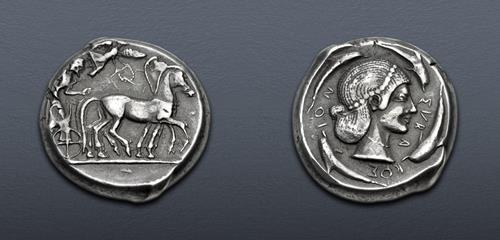|
SICILY, Syracuse. Hieron I. 478-466 BC. AR Tetradrachm (22mm, 16.99 g, 2h). Struck circa 478-475 BC. Charioteer, holding kentron and reins, driving slow quadriga right; above, Nike flying right, crowning horses with wreath / Head of Arethousa right, wearing pearl tainia; four dolphins around. Boehringer Series XIa, 192 (V87/R131); HGC 2, 1306; Bement 454 (same dies). Attractively toned, faint scratch in field on obverse. Good VF. Well centered.
The ascendancy of the Deinomenid tyrants, Gelon (485-478 BC) and Hieron I (478-466 BC) brought Syracuse to the status of greatest city west of mainland Greece, rivaling Athens in wealth and prestige. Ironically, the family of Deinomenes, the clan’s patriarch, originally hailed not from Syracuse, but from Gela, to which the Syracusan aristocratic caste called the Gamoroi appealed for help after being overthrown and ejected in a popular revolution circa 486 BC. As the eldest son of Deinomenes and Gela’s military strongman, Gelon raised his own army and used it to capture Syracuse, but instead of reinstalling the Gamoroi, Gelon retained power for himself as a tyrant. The rule of Gelon, and later his brother Hieron I, was largely benevolent, though other Sicilian cities, including their native Gela, were often treated harshly. In 480 BC, Gelon defeated a major Carthaginian invasion at Himera, perhaps undertaken in complicity with the Persian attack of Xerxes I on the Greek mainland. He was thus hailed as a savior of Greek civilization along with the Athenian and Spartan heroes of Salamis and Plataea. Hieron I, assuming power after his brother’s death, expanded Syracuse’s influence onto the Italian mainland, where he won another signal victory over the Etruscans at Cumae in 474 BC. Both Deinomenids embellished Syracuse with amphitheaters, libraries, and other civic buildings, and were liberal patrons of art and literature. On the other hand, Hieron employed a secret police force, the first in Greek history, to retain his grip on power. Syracusan coinage entered its first phase of greatness under their guidance, with the obverse prominently celebrating the city’s repeated Delphic and Olympic victories in chariot racing. The reverse image of Arethousa, nymph of the city’s central spring of Ortygia, was rendered in the high archaic style of the period, much as was Athena’s head on the contemporary coinage of Athens. Though both Gelon and Hieron were addressed as “king” by some contemporaries, there is no evidence they adopted the royal title and their names never appear on Syracusan coins. A third Deinomenid brother, Thrasybolos, attempted to rule Syracuse after Hieron’s death in 466 BC, but was quickly overthrown and replaced by a democratic government.
The final winners of all CNG Feature Auction 129 lots will be determined during the live online sale that will be held on 13-14 May 2025. This lot is in Session One, which will begin 13 May at 9 AM ET.
Winning bids are subject to a 22.5% buyer's fee for bids placed on this website and 25% for all others.
We recognize that our users may have various Internet Browsers and Operating Systems. We like our visitors to have the best possible experience when using our bidding platform. However, we do recognize that it is impossible to develop applications that work identically, efficiently and effectively on all web browsers. The CNG bidding platform supports the latest stable major version and stable previous version of Chrome and Firefox.
|
